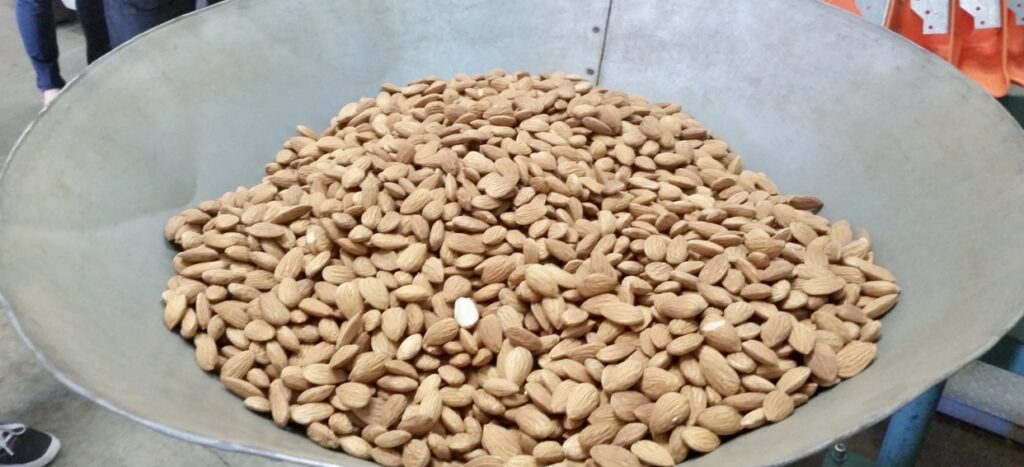I visited an almond orchard for a first-hand look into everything almonds. From planting, growing, hulling and shelling to processing, packaging and quality control – here’s a look into how almonds go from farm to table.

I love visiting farms. Seeing first-hand how our food is grown gives a whole new perspective, and respect, for the food and the farmers that grow it. A lot more goes into it than most people think about. We have incredible technology to make the process easier, but much of farming is still very hands-on. When you see farmers in the field, it makes you appreciate every bit of food. Think twice before you toss your extras in the trash, or you take more than you know you can eat. A lot went in to making it available to you.
That’s why I never turn down a chance to visit a farm. My most recent visit was to Stewart & Jasper Orchard in Modesto, California. The invitation came just in time for almond harvest. I love almonds, so I was beyond excited for this trip.
If you follow me on twitter, you might have read some of my tweets from the visit. It was tons of fun, and eye opening, too. I was so excited to stand in the field, and was even allowed inside the packaging plant. The farming process is fascinating. That’s why, I wanted to share in a post. Here’s what I saw, and learned about almonds and how they go from tree to table.

Where Do Almond’s Grow?
California produces 80% of the worldwide production of almonds. The state’s cool, wet winters, near zero humidity and hot summers, make it the perfect climate for farming nuts.
Modesto, the area that I visited, is known for being foggy. The trees love to soak up the moisture.
Almonds Grow on Trees!
Almonds are considered tree nuts for a reason – they grow on trees. Almond trees begin producing nuts around four years old, and continue producing until ~10-11 years of age. During the early stages of bloom, when the trees awaken, they form small pink buds. Those buds continue to blossom, which is referred to as popcorn until the tree is filled with beautiful pink and white flowers. Once the tress reach full blossom, beautiful pink and white colored trees fill the orchard. During my tour, the farmer explained that one of the first sign of spring in Modesto, is the pink and white colored blossom that comes from the almond tree.

How Are Almonds Farmed?
Producing almonds require a lot of water, which is always a concern in California. Another concern that almond farmers face is the availability of honey bees. They are a necessary part of the process, since they are required to pollinate the tress. The health of bee colonies is something that almond farmers take very seriously. It’s also the biggest expense for almond growers.
Before you know it, green almonds are visible from the branches.
Green almonds get their name from the color of their hull. At this stage, they are not ripe, but they are edible. If you open the shell, Inside you’ll find a very smooth, white colored almond. As the green almond begins to dry out, it splits, exposing the nut inside. It takes a couple of weeks to completely dry. Once it does, harvest begins.

The Harvest Of Almonds
Harvesting almonds involves mechanically shaking the trees. A truck drives through the orchard, grabs the trunk of the tree, then shakes it until the almonds fall to the ground. They are left there between four and seven days, when a sweeper comes through and gathers the almonds into rows. That allows for easier pick-up.
After each orchard is swept, the harvest is collected into field carts, where it is then transferred to a handling facility. The factory is where the hulling process begins.

How Are Almonds Hulled, Sorted And Packaging For Consumers?
Once the almond harvest arrives at the factory, the stages of hulling begin. Much of this process requires manual labor. It starts with a pre-cleaner phase, then the outer hull of the almond is removed by the huller. A sheller removes the hard shell from the almond kernel. The hulls are not thrown away, though. They are stored for later use.

They then move to the sizer, where the nuts are calibrated into various screen sizes. Laser technology is first used to ensure quality and sorters manually remove damaged kernels and any foreign materials. Throughout the entire process, quality is continually checked to meet USDA standards.
Almonds are then packed in 50 pound cartons or one tons fiber bins. Each bin holds the crop of ~ one acre of trees. Once boxed, they are kept in refrigerated storage awaiting shipment.

The product is maintained and tracked during delivery, too.
This trip walked me through the entire almond process, from growing to hulling & shelling to processing, quality and finally marketing. It was a fantastic experience.

On the way out, I was given a small container of almonds. A great snack for the plane ride home!


 Hi, I’m Heather – a registered dietitian, busy mom, consultant, adventure junkie and travel addict who has mastered living healthy on the go. My blog is where I share simple recipes and healthy living tips to help and inspire others to live their best life.
Hi, I’m Heather – a registered dietitian, busy mom, consultant, adventure junkie and travel addict who has mastered living healthy on the go. My blog is where I share simple recipes and healthy living tips to help and inspire others to live their best life.